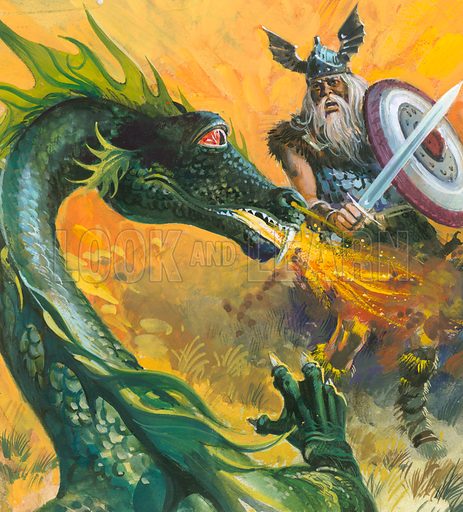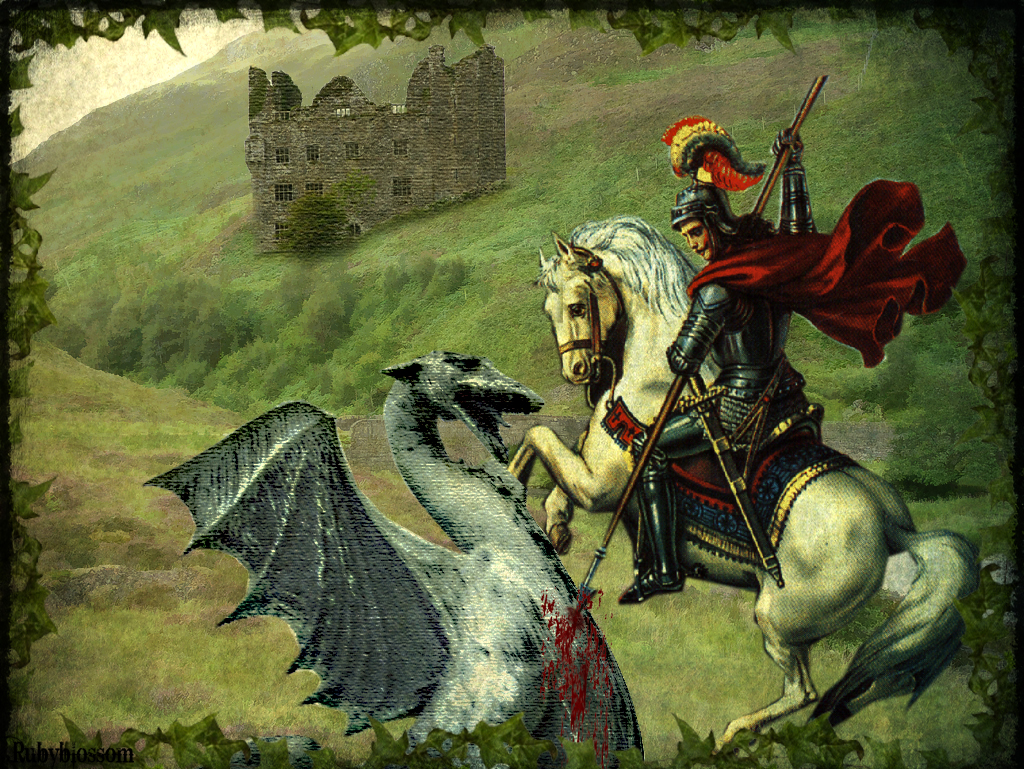Rich in symbolism and meaning, St George is the patron saint of England.
The mainstream and ‘woke’ narratives would have us believe that St George was an ethnic Turk who defeated a dragon that was holding a fair maiden hostage, possibly as a sacrifice offered up to the beast by the local people.
However, what if the reality is that the story is simply a re-working of a far older one?
What if it is simply a re-imagining of another ancient story of heroism from a dimly remembered past?
Could it be a re-telling, brought forward to the current time in which the St George or a character like him was living?
Whilst there exist numerous examples of a hero overcoming huge odds to defeat a fearsome creature, the one that occurs to me on this the 23rd day of April, 2024, is that of Beowulf.

Beowulf is an ancient tale of a hero who clears shipping lanes of sea monsters, who defeats the monstrous Grendel and his mother who are terrorising King Hrothgar the Dane and his great hall of Heorot and a hero who kills a dragon later in his life.
On top of which, there is historical evidence that Beowulf did actually exist and, of course, that he was what we would call Caucasian. The existence of creatures like dragons, griffins and sea serpents may well not be as mythical as we are led to believe.
The late William Cooper, in his extraordinary book, “After the flood: The Early Post-flood History of Europe Traced Back to Noah”, details the historical accuracy of the Beowulf narrative to the point where he lays out the evidence that Beowulf and the other characters were actual people whose existence is demonstrated in the historical records that survive to this day. Of Giants, Dragons and Men
The erudite Jason Breshears of archaix.com cites an incredible amount of evidence that the Antediluvian World before the Great Flood of 2239BC was of a different climatic character with high levels of oxygen, CO2, a world rich in nutrients, infra red light and ambient radiation from Volcanic activity; all of which produced a climate that was conducive to megafauna and flora growing to prodigious sizes.
In “Memories and Mechanics of the Vapour Canopy World”, Mr Breshears writes,
“The concept of a Vapour Canopy was introduced in 1912 by Isaac Vail in a book The Canopy and Longevity of Life. Vail was also the first to appeal to the water canopy’s greenhouse effect to advocate a universally warm earth, the first to claim that this would result in no rain on the earth and the first to claim that the blocking of the sun’s rays would lead to great longevity among human kind.
It would be 24 more years before the concept was seriously revisited. Harry Rimmer embraced the Canopy in his 1936 work The Harmony of Science and Scripture, stating the Earth was surrounded by a “protecting lens of ice that made the whole world an Eden of tropical splendour.”
In the same year Kellog published his research. After an analysis of numerous mythological accounts of the ancient earth, Kellogg concludes that many of them tell of a visible water heaven scintillating with light. (Kellogg, Howard, The Coming Kingdom and the Re-Canopied Earth, 1936, p. 23.)
Still, it would be another 25 years before the concept would return and be widely received.
In 1961 the combined work of Whitcomb and Morris in The Genesis Flood has presented the most persuasive and well-documented case for the Vapor Canopy, so much so, that the scientific community now began to defend itself against the concept because the uniformitarian model of science can not allow for a historical Vapor Canopy.
Twenty-one years later Joseph Dillow in The Waters Above: Earth’s Pre-Flood Vapor Canopy was published in 1982. Dillow lists a number of traditional accounts that demonstrate a memory of the canopy.
The effects of the Vapor Canopy is no longer theoretical. Creationist scientists in Glenrose, Texas have built a Hyperbaric Biosphere, a chamber where they replicated the canopy conditions and the result was much larger plant life forms inside the biosphere. The life span of fruit flies tripled, and similar organisms underwent changes.”
All of which would suggest, at least for me, that our allegiance to St George is a profound ancestral memory in the shape of a more contemporaneous knightly figure. As such, it stands as a more recent reworking of an ancient memory of a time when lizards, reptiles, birds, insects and sea creatures all grew to enormous sizes. The warriors (some of whom were of giant stature) who were able to protect the people and clear the menace of these creatures were real heroes, whose achievements and exploits were immortalised in the spoken and written word. If true, it follows that their deeds became the stuff of legends, and that characters like St George were created from those collective memories, not unlike how the same ancient heroes morphed into the comic book characters of the Marvel comics.
There is nothing new under the sun but that is not to say St George should not be valued as a latter day incarnation of a well-remembered caucasian hero of ancient lore.
‘Cry ‘God for Harry, England, and Saint George!’’
Further recommended viewing
Acambaro Artefacts of the Vapor Canopy World




